|
|
 |
 |
 |
 |
 |
 |
 |
"Assiette à petites palmes" from the service presented by Louis XV to King Frederick V of Denmark in March 1758 |
 |
 |
|
 |
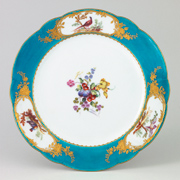 |
 |
"Assiette à petites palmes" from the service presented by Louis XV to King Frederick V of Denmark in March 1758
The Vincennes Porcelain Manufactory
1756
Musée du Louvre, Department of Decorative Arts
Soft-paste porcelain
Gift of Albert and Paul Pannier, 1918
inv. OA 7197.
H. 4 cm; Diam. 24.7 cm
© 2010 Musée du Louvre / Martine Beck-Coppola |
|
 |
This green-ground plate (assiette à petites palmes) comes from the service of "green-ground French porcelain painted with figures, flowers, and birds" that Louis XV presented in March 1758 to King Frederick V of Denmark—the first beneficiary of diplomatic gifts in the form of porcelain—to thank him for his gift of a stallion of the famous Frederiksborg breed. The service's green ground (a recent addition to the colors used at Sèvres), 72 plates (at the high price of 60 livres1 each1), and 164 hollow ware pieces (required for the proper French-style service) justified its very high price of 34,542 livres.
It was purchased from the Sèvres Porcelain Factory by Lazare Duvaux, merchant of the King, and delivered on December 9, 1757 to the Abbé-Comte de Bernis, Minister of Foreign Affairs, who in turn sent it to Denmark.
Although it pleased King Frederick, the major part of the service entered the imperial Russian collections at an unknown date, and is now in the Hermitage Museum of St. Petersburg.
1. livre : the French currency of the day |
 |
|
 |
 |
 |
 |
"Assiette à guirlandes" decorated with green ribbons from the service presented by Louis XV to Empress Maria Theresa of Austria on December 2, 1758 |
 |
 |
|
 |
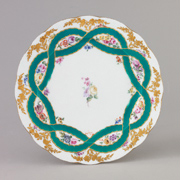 |
 |
Pierre-Antoine Méraud l'Aîné, active from 1754 to 1791
"Assiette à guirlandes" decorated with green ribbons from the service presented by Louis XV to Empress Maria Theresa of Austria on December 2, 1758
The Sèvres Porcelain Manufactory
1757
Musée du Louvre, Department of Decorative Arts
Porcelaine tendre
Gift of Albert and Paul Pannier, 1918
OA 7192.
H. 3.5 cm; Diam. 24 cm
© 2010 Musée du Louvre / Martine Beck-Coppola |
|
 |
his garland plate (assiette à guirlandes) belongs to the service decorated with green ribnons that Louis XV presented to Empress Maria Theresa on December 2, 1758, to seal the "reversal of alliances" decided by France and Austria the previous year with the Treaty of Versailles (May 1, 1757). In addition to the 185 pieces of the service (including 74 plates at 72 livres each), this present valued at 24,768 livres featured many other porcelain pieces from the Sèvres Manufactory.
While most of the hollow ware pieces are still in the Hofburg Imperial Residence in Vienna, the "garland" plates are now dispersed, and two of them belong to the Louvre. |
 |
|
 |
 |
 |
 |
"Compotier" round fruit dish from the service presented by Louis XV to the Elector Palatine in 1760 |
 |
 |
|
 |
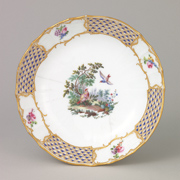 |
 |
"Compotier mosaïque" fruit dish from the service presented by Louis XV to the Elector Palatine Charles Theodore in April 1760
The Sèvres Porcelain Manufactory
1759
Musée du Louvre, Department of Decorative Arts
Soft-paste porcelain
Bequest of Madame Adolphe Thiers, 1881
TH 1180.
H. 5 cm; Diam. 22 cm
© 2010 Musée du Louvre / Martine Beck-Coppola |
|
 |
This round fruit dish (compotier) belongs to a service decorated with mosaic, flowers and birds that was presented by Louis XV to the Elector Palatine, Charles Theodore in 1760 to ensure his neutrality with regard to the new alliances introduced by the Treaty of Versailles.
The service, comprising 96 plates (at 36 livres each), 122 service pieces, and 54 biscuit figures, cost 15,736 livres.
Each of the 20 fruit dishes was priced at 60 livres.
The service was sent to Manheim, and so pleased the Elector Palatine that he decided not to use it but rather to exhibit it in purpose-made display cases. The major part of the service has been preserved since the late 18th century at the Residence in Munich. The fruit dish entered the Louvre's collection thanks to the bequest of Madame Thiers in 1881. |
 |
|
 |
 |
 |
 |
Tureen from the "service à frise riche en couleurs" delivered to Queen Marie Antoinette on August 26, 1784, and tray delivered on September 7, 1784 as an addition to the service presented by Louis XVI to King Gustavus III of Sweden on June 22, 1784 |
 |
 |
|
 |
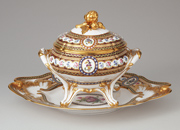 |
 |
■Pot
Jacques-François Micaud Père, active from 1757 to 1810, and Etienne-Henri Leguay l'Aîné, gilder, active from 1748 to 1749 and from 1751 to 1796
"Pot à oille" (tureen) from the "service à frise riche en couleurs" delivered to Queen Marie Antoinette on August 26, 1784
The Sèvres Porcelain Manufactory
1784
Musée du Louvre, Department of Decorative Arts
Soft-paste porcelain
Acquis en 2001
OA 11979
H. 25 cm; W. 28.5 cm; Diam. (lid): 23 cm
© 2010 Musée du Louvre / Martine Beck-Coppola
■Tray
Jacques-François de Laroche, active from 1758 to 1802, and Henri-François Vincent l'Aîné, gilder, active from 1753 to 1800
Tray from the "service à frise riche en couleurs" presented by Louis XVI to King Gustavus III of Sweden on June 22, 1784
The Sèvres Porcelain Manufactory
1784
Musée du Louvre, Department of Decorative Arts
Soft-paste porcelain
Acquis en 2001
OA 11980
H. 5.5 cm; W. 46.2 cm; L. 37.5 cm
© 2010 Musée du Louvre / Martine Beck-Coppola
|
|
 |
A service of over 300 pieces with a richly-colored border (à frise riche en couleurs), originally commissioned by Marie-Antoinette early in 1784 (perhaps for the Tuileries Palace), was finally presented together with other gifts on June 22, 1784, by Louis XVI to King Gustavus III of Sweden during the latter's visit to France.
The tray, with its tureen, was priced at 600 livres and was the most expensive part of the service. It was delivered to the Swedish king as an addition to the service on September 7, 1784. The tureen comes from the second service that was immediately put into production for Queen Marie-Antoinette and delivered on August 26, 1784. |
 |
|
 |
 |
 |
 |
Bottle cooler from the service presented by Louis XV to Queen Maria Carolina of Naples in 1773 |
 |
 |
|
 |
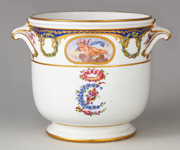 |
 |
Etienne-Jean Chabry fils, active from 1764 to 1787,
Jean-Baptiste Tandart l'Aîné, active from 1754 to 1800, François Baudouin Père, gilder, active from 1750 to 1800, Michel-Barnabé Chauvaux l'Aîné, gilder, active from 1752 to 1788
Bottle cooler "ordinaire" from the service presented by Louis XV in 1773 to Queen Maria Carolina of Naples (Carlotta Luisa)
The Sèvres Porcelain Manufactory
1773
Musée du Louvre, Department of Decorative Arts
Soft-paste porcelain
Gift of Mlle Marcelle Brunet, 1983
OA 10879
H. 17 cm; Diam. 18 cm; W. 23 cm
© 2010 Musée du Louvre / Martine Beck-Coppola |
|
 |
This bottle cooler belongs to the service presented in 1773 by Louis XV to Queen Maria Carolina of Naples, sister of the Dauphine Marie-Antoinette.
This blue-bordered service decorated with children and baskets bore the monogram CL— probably the initials of Queen Maria Carolina Louisewhose daughter, Charlotte-Louise, was Louis XV's goddaughter.
According to the references in the Journal des présents du Roi of January 1774, each of the two bottle coolers cost 192 livres. |
 |
|
 |
 |
 |
 |
Oval platter delivered on March 1, 1776 as an addition to the service presented by Louis XV to Maria Luisa of Parma, Princess of Asturias in 1773 |
 |
 |
|
 |
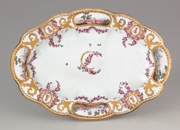 |
 |
François-Antoine Pfeiffer, active from 1771 to 1800, and Jacques Pierre known as Pierre l'Aîné, gilder, active from 1759 to 1776
Oval "plat à contours" (platter) delivered on March 1, 1776 as an addition to the service presented by Louis XV to Maria Luisa of Parma, Princess of Asturias, in 1773
The Sèvres Porcelain Manufactory
1775
Musée du Louvre, Department of Decorative Arts
Hard-paste porcelain
Purchased in 1984
OA 11022
H. 4 cm; W. 38 cm; L. 27 cm
© 2010 Musée du Louvre / Martine Beck-Coppola |
|
 |
In late 1773, Louis XV commissioned a service from the SèvresManufactory for his granddaughter Maria Luisa of Parma (1751-1819), Princess of Asturias, who was to become Queen of Spain in 1788.
Most of the service was produced in 1774 and delivered to Madrid in January 1775, almost a year after Louis XV's death.
The service comprised 225 pieces and cost 22,015 livres. The Princess liked it so much that a number of additions were produced (until 1791), such as the one dating from March 1, 1776 which included the Louvre's oval platter, priced at 240 livres. |
 |
|
 |
 |
 |
 |
"Dolphin garden" vase presented by Louis XVI to Prince Henry of Prussia on October 22, 1784 |
 |
 |
|
 |
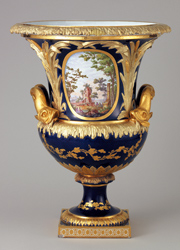 |
 |
Pierre-Joseph Rosset l'Ainé, active from 1753 to 1795, and
Jean-Pierre Boulanger, gilder, active from 1753 to 1795
"Dolphin garden" vase presented by Louis XVI to Prince Henry of Prussia on October 22, 1784
The Sèvres Porcelain Manufactory
1781
Musée du Louvre, Department of Decorative Arts
Hard-paste porcelain
1997
OA 11854
H. 48 cm
© 2010 Musée du Louvre / Martine Beck-Coppola |
|
 |
In 1784, Prince Henry of Prussia, the younger brother of King Frederick II, also visited France.
Louis XVI showered Prince Henry with gifts in the form of Gobelins tapestries and Sèvres porcelain, notably a green-ground table service and vases including a pair costing 2,400 livres, one of which was presented to the Louvre in 1997.
The shape and dating of this vase "jardin à dauphins" suggest that it may have been made in anticipation of the birth of the first Dauphin2 in October 1781.
2. Dauphin: the title of the eldest son of the king of France, and the French for "dolphin". |
 |
|
 |
 |
 |
 |
Soup plate from the service presented on June 12, 1786, by Louis XVI to Archduke Ferdinand of Austria, Governor of Lombardy |
 |
 |
|
 |
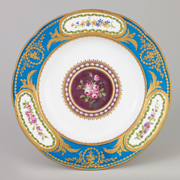 |
 |
Cyprien-Julien Hirel de Choisy, active from 1770 to 1811, and Michel-Barnabé Chauvaux l'Aîné, gilder, active from 1752 to 1788
Soup plate from the service presented by Louis XVI to Archduke Ferdinand of Austria, Governor of Lombardy, on June 12, 1786
The Sèvres Porcelain Manufactory
1785
Musée du Louvre, Department of Decorative Arts
Soft-paste porcelain
Purchased in 2001
OA 11916
H. 5.5 cm; W. 46.2 cm; L. 37.5 cm
© 2010 Musée du Louvre / Martine Beck-Coppola |
|
 |
In June 1786, Louis XVI purchased from the Sèvres Manufactory a service with a “bleu céleste ground, Marguerites, cornflowers, and Roses” for his brother-in-law, Archduke Ferdinand of Austria, Governor of Lombardy, who was visiting France incognito in the company of his wife. The service, intended for the Milanese court, comprised 288 service pieces, together with other porcelain items for a total cost of 24,073 livres. The 30 soup plates, including the one presented to the Louvre, were priced at 36 livres each.
The 30 soup plates, including the one presented to the Louvre, were priced at 36 livres each. |
 |
|
 |
 |
 |
 |
Bust of Queen Marie Antoinette |
 |
 |
|
 |
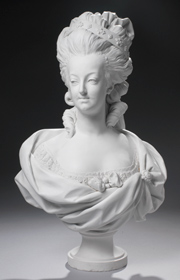 |
 |
Bust of Marie Antoinette
After Louis-Simon Boizot,
commissioned by Prince Alexander Kurakin
1782
Musée du Louvre, Department of Decorative Arts
Hard-paste porcelain
Gift in memory of Sir Robert Abdy, 1982
OA 10898
H. 40 cm
© 2005 Musée du Louvre / Peter Harholdt |
|
 |
This bust of Queen Marie Antoinette, originally paired with a bust of the King, was commissioned from Sèvres in 1782 by Prince Alexander Borisovich Kurakin (later Russian ambassador in Paris, from 1808 to 1812); the latter visited France with the Tsarevich and his wife, who traveled incognito as the "Count and Countess of the North".
This biscuit model was made by Louis Simon Boizot—director of the sculpture workshop at Sèvres since 1773—who seems to have heeded criticism of the haughty marble bust of the Queen he made in 1781 for the Secretary of State for Foreign Affairs and which is now in the Louvre. |
 |
|
|
 |